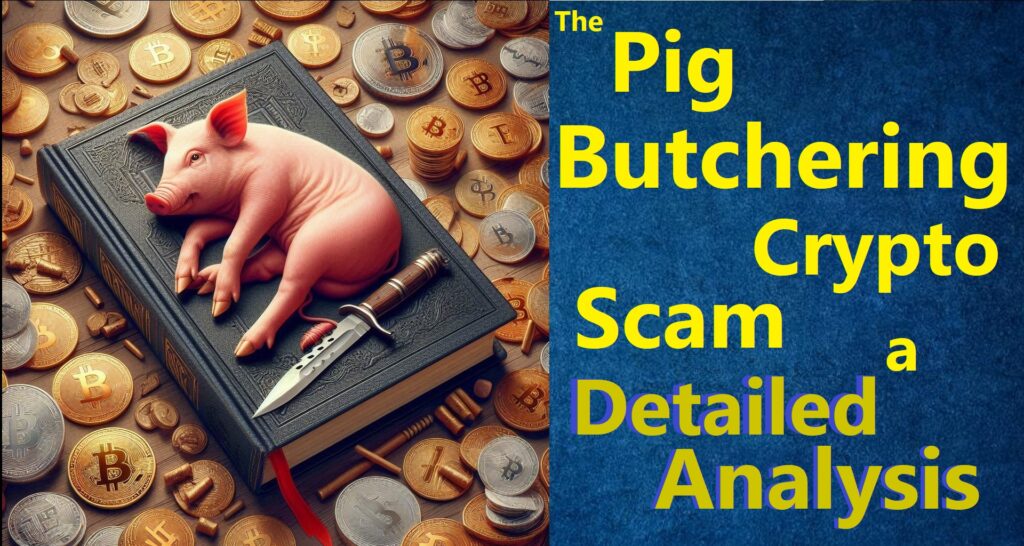What is
pig butchering?
Pig butchering is a theft that relies on the trust of the victim that occurs over a long period of time, involves a fake identity by the scammer, initial contact by the scammer, an increase of investment in the scam by the victim, and a sudden escape by the scammer.

pig butchering
a sub-type of the "long con" confidence game

Pig Butchering is a new twist on an old type of confidence game. Pig butchering is a type of “long con.” A long con is a confidence game involving multiple stages over a long period of time. The initial stages are designed to gain the victim’s trust. Middle stages involve increasing the profitability of the scam. The last stages include theft and escape. Characteristics of a long con include:
- Complexity: Long con scams are elaborate. They are planned out well in advance. They often involve a team of thieves with specialized individual roles.
- Long Time Period: Long cons take time to complete. The time period will depend upon how long it takes the scam to be completed. This may entail, days, months, even years to unfold.
- Trust: Con artists perpetrating a long con rely upon the potential victim lowering their defenses. The victim is known as the “mark” in the business. The mark/victim voluntarily lowers their defenses based upon their trust of the thief.
- Illusion of Control: Trust is frequently inadequate for a long con artist to complete the scam. Remaining skepticism is addressed by created a mirage that the victim remains in control to address feelings of risk.
- A Created Stage: Long con scams nearly always involve a setting that has been created to bolster that their scam is a reality. This “stage” may include props, sets, fake offices, fake websites, extra actors, and scripted lines.
- Bypassing Small Profits: Long con artists intentionally and overtly turn down opportunities to profit small amounts. Such gestures are contrived to bolster trust, a feeling of security, and lower the mark’s defenses.
- A Contrived Emotion of Security: Long con scams have the goal of enticing the target victim into feeling the emotion of security. A long con depends upon its victim voluntarily allowing the theft because they feel no risk.
pig butchering
as a farming reference
Pig butchering is a name taken from farming. It is typical for a pig farmer to fatten a pig before killing it. Over a period of several months, the farmer feeds the pig a high fat diet to increase its fat percentage. In addition, the fattened pig is kept in a low stress environment to keep cortisol and epinephrine hormone levels low to maximize meat quality.
Young “suckling” pigs are butchered at six to eight months of age for their high quality tender meat. Older pigs of two years or older yield much more meat, but have higher myoglobin and intramuscular fat, yielding a larger quantity of darker, lower quality meat. Time matters when it comes to pig butchering, whether at a farm or through a crypto scam.
The process of human pig butchering scam victims is analogous.


where did
pig butchering scams originally come from?
“Pig butchering” originated in China. The Chinese term is “shu zhu pan.” Its translation means “killing pig plate.” The first Chinese pig butchering scams started in 2016 as a regional crime perpetrated on same-sex dating sites. It was an effective scam.
Pig Butchering expanded in type to opposite sex dating sites, then to gambling operations, then through multiple scam types. Pig butchering scams also expanded in location. They spread from China to Sihanoukville, Cambodia, to the Philippines, then to Thailand, then globally.
Pig butchering scams are perpetrated in different flavors. The type of scam will relate to a combination of (1) how the victim’s trust is gained, and (2) how possession of the victim’s assets is gained. The types of pig butchering scams include:
- Investment scams
- Romance/Confidence – Catfishing Scams
- Fake Crypto Trading Website Scams
- Fake Liquidity Provider Scams
- Fake Initial Coin Offerings (ICOs)
- Lottery / Sweepstakes / Inheritance
- Simulated Gambling
- Fake Gaming App – Play to Earn
- Simulated Arbitrage
- Personal Data Breach / Phishing for confidential information
- SIM Swap
- Tech-Support scams
- BEC Business Email Compromise
- Government impersonation
- Identity Theft
- The fake Bait and Switch Investor
- Real Estate scam
- Ransomware
- Malware
- BOTnet
- Extortion
- Harassment / Stalking
- Fake crypto scam recovery efforts
- Non-Payment, Non-Delivery
- Overpayment scam
- Copyright / Counterfeit scam
What are the types
of pig butchering scams?


What are the worst
pig butchering scams?
Romance based pig butchering scams rank number one (#1) by a sizeable margin as measured by average payout. The list of the top scams is as follows:
- 1. Romance Average = $4,593.00
- 2. NFT scams Average = $4,095.00
- 3. Giveaway Average = $1,113.00
- 4. Impersonation Average = $948.00
- 5. Charity Average = $904.00
- 6. Phishing Average = $750.00
- 7. Extorsion Average = $750.00
- 8. Investment Average = $413.00
- Unsolicited contact: Be wary of unexpected messages from unknown numbers or social media accounts. Also, be careful on dating apps to verify that the contact is a real person.
- Too-good-to-be-true investments: Claims of guaranteed high returns with little or no risk are red flags. If it sounds too good to be true, it probably is.
- Pressure to invest quickly: Legitimate opportunities rarely require rushed decisions.
- Romantic interest from strangers: Be cautious of online suitors who quickly profess strong feelings and then ask for money.
- Requests for personal information: Don’t share sensitive data like bank details with unverified individuals.
Warning signs
of a pig butchering

- Unregistered investment platforms: Check if investment websites or apps are registered with official regulators.
- Difficulty withdrawing funds: Be suspicious if you can’t easily cash out your supposed investment returns.
- Inconsistent or vague details: Watch out for contradictory information or a lack of concrete specifics about the supposed investment.
- Promises of easy riches: Be skeptical of anyone claiming that you can get rich quick with minimal effort.
- Persistent attempts to isolate you: It’s a red flag if scammers try to monopolize your attention and cut you off from loved ones.
what are the stages
of a pig butchering scam?

There are four general stages of a pig butchering scam. The goal is to lure the victim into voluntarily giving up an increasingly large amount of their assets. Pig butchering stages include:
- 1. Trust Creation: Scammers start slowly and avoid any indication of a profit motive. The goal of stage one is gaining the victim’s trust so as to lower the victim’s guard. This is done by offering helpful advice, indicating romantic interest, fostering friendship, and giving other value.
- 2. The Lure: Once trust is established, the potential victim is introduced to an enticing offer. Whatever the offer may be, it will have two components. First, it will seem innocent, trustworthy, and profitable. Second, the offer will involve the victim giving up control of assets.
- 3. Money Release: Stage three has the pig butchering victim transferring control of assets. This may be a transfer to the scammer, personally. Often the transfer is to a “trusted” third party. Cryptocurrency is often used as a means of transfer. The victim at this point will believe they can reverse the transaction. In some instances, small “test” withdrawal transactions are allowed. The critical attribute of the Money Release stage is the permanent loss of custody of the majority of the victim’s released assets.
- 4. The Fattening: The victim will ostensibly see their “investments” rise in value during this stage. Efforts will be made to increase trust in the investment. Efforts will be made to isolate the victim, causing them to mistrust sources other than the scammer. Key to this stage is the acceleration of the amount of investment.
- 5. The Vanishing: The scammers exit when they conclude they have extracted as much of the assets of the victim they can get. Communication channels are normally cut. Websites are abandoned. Funds are tumbled, mixed, divided, filtered through many transactions channels to hide their final destination. The goal of Stage Four Vanishing is escape with no means of redress for the pig butchering victim.
THE RELEASE OF FUNDS SCAM – ADDING SALT TO A WOUND
Pig Butchering After Scams:
A tip off and nuance of the pig butchering scam is the demand for additional money for the release of scammed funds. These money demands are for taxes, fees, costs, early withdrawal penalties, and other excuses. The tipoff is that money must be paid to release money, which is nearly never the case in legitimate businesses.
More rarely, “after” scammers pose as recovery specialists, who ask for money up front to recover assets, then disappear.
WHAT MEANS OF COMMUNICATION ARE USED FOR PIG BUTCHERING SCAMS?
There are common communications for pig butchering scammers. The channels are chosen by ease of entry, lack of confirmation of identity, and ease of escape. These channels include:
Text messages
Dating apps, like Tinder, Bumble, Hinge, and OkCupid
Social media platforms like Facebook, WhatsApp, Instagram, WeChat, Telegram, Snapchat, and Pinterest
VOIP chat apps like WhatsApp, KrispCall, 8×8, OpenPhone, GoogleVoice, and RingEx
Email applications like Gmail, Outlook, Yahoo, AOL, Canary Mail, and Zimbra

The largest number of pig butchering scams come from the following nations:
- North Korea
- Russia
- Myanmar (Myanmarese town, Myawaddy, Cambodia)
- Iran
from where
do the scams originate?

Other “hot spots” for crypto crime include:
- United States
- United Kingdom
- Japan
- Hong Kong
- Canada
- British Virgin Islands (BVI)
- Seychelles
- South Korea
- Singapore
- Vanuatu
- Poland
- New Zealand
- Italy
- Marshall Islands
- Switzerland
There are major players within the cryptocurrency criminal industry. These individuals and organizations are the most sophisticated players. They also comprise the largest recipients of crypto-based criminal activity.

who are the "big players?"
among cyber criminals
Crypto criminal enterprises include:
- Kimsuky espionage: North Korea
- io mixer: Netherlands, Finland, Russia
- Ekaterina Zhdanova money laundering: Russia
- MSB Buy Cash terrorism financing: Gaza
- Fentanyl Drug Producers: China
- Sinaloa Cartel drug trafficking and money laundering: Mexico
- Trickbot affiliates ransomware: Russia
- John Desmond Hanafin, and Affiliates sanctions evasion: Dubai/Russia
- Mikhail Matveev ransomware: Russia
- DPRK money laundering: China
- Genesis Market fraud and stolen PII: Russia
- Trickbot malware: Russia
- Igor Vladimirovich Zimenkov arms dealing: Russia
WHAT CIVIL LAWS ARE BEING BROKEN BY PIG BUTCHERING SCAMMERS?
- Conversion to Chattels
- Trespass to Chattels
- Conversion of Real Property
- Trespass to land (realty)
- Intentional Misrepresentation
- Fraud
- Interference with contractual relations
- Breach of Warranty of Title to Personalty
- Breach of Implied Warranty of Fitness for a Particular Purpose
- Breach of Implied Warranty of Merchantability
- Intentional infliction of emotional distress
- Negligent infliction of emotional distress
- Misappropriation
- Breach of contract
- Nuisance
- Seduction
- Malpractice
- Quantum Meruit
- Negligence Per Se
- Res Ipsa Loquitur
- Conspiracy
- Replevin
- Trover
WHAT CRIMINAL LAWS ARE BEING BROKEN BY PIG BUTCHERING SCAMMERS?

can crypto scammers
be prosecuted?

Over sixty thousand crypto scam crimes are reported in the United States, alone, every year. From that large number, only a very few cases are brought against cyber criminals.
Consider how few cases are attempted among the top ten countries:
- 30 cases in North Korea
- 15 cases in the United States
- 8 cases in Russia
- 9 cases in China
- 13 cases in the United Kingdom
- 6 cases in Japan
- 5 case in Hong Kong
- 5 cases in Canada
- 3 cases in the British Virgin Islands
- 4 cases in the Seychelles
Of those few filings, virtually no cyber criminals are convicted or serve any time in prison. There are a number of reasons for the paltry number of criminal convictions of crypto scammers. Those reasons include the inability of identifying the culprit, the fact that the vast majority of criminals are foreign nationals from countries without an extradition treaty, and the diffusion of culpability across multiple members of criminal gangs. Intent to commit a crime is also an issue, surprisingly. Many times, the person committing the crime is being held against their will and is being forced by a criminal gang.

There have been no published cases involving “pig butchering” in any U.S. court as of the date of this publication. This search includes:
- State appeals courts
- State Supreme courts
- Federal district courts
- Federal appeals courts
- The United States Supreme Court
pig butchering scams
in the courtroom
The lack of appearance of pig butchering cases is United States Courts is indicative of their international nature, the lack of an effective means of gaining jurisdiction over the criminals, the ability to enforce any judgment against scammers, and the high economic costs of bringing lawsuit.
There is a small group of crypto scam recovery lawyers working to achieve justice using the legal system presently. Whether these efforts will ultimately succeed, expand, fail, or contract is unknown.
CAN STOLEN CRYPTO FROM A PIG BUTCHERING SCAM BE RECOVERED?
Crypto stolen by pig butchering scammers can only be recovered in rare cases. It is common for victims to believe they merely need to file a police report, or disclose to the FBI, and their crypto will be returned. This is not the case.


what must be done?
to recover from a pig butchering scam
There is hope for the some to recover their scammed crypto. The precise method of recovery is kept secret by crypto recovery lawyers to reduce the likelihood that scammers will adapt their methods to further evade culpability.
Do you represent a crypto loss that qualifies for a recovery effort?
Contact us if you have been scammed out of more than $200,000 in crypto.
Your losses may be recoverable.
Trial lawyer Matt Hamilton graduated from the University of Missouri in 1995 with Science degrees in Logistics, Marketing, and Business Administration. Juris Doctor, 1999.

bibliography
- Wang, Fangzhou (2024). “Victim-offender overlap: the identity transformations experienced by trafficked Chinese workers escaping from pig-butchering scam syndicate”. Trends in Organized Crime. doi:10.1007/s12117-024-09525-5 – via Springer Link
- Individual Frauds in China: Exploring the Impact and Response to Telecommunication Network Frauds and Pig Butchering Scams, Bing Han, University of Portsmouth, September 2023. https://pure.port.ac.uk/ws/portalfiles/portal/81985344/Bing_Han_PhD_thesis.pdf
- Deconstructing a form of hybrid investment fraud: Examining ‘pig butchering’ in the United States, Marie-Helen Maras, Emily R. Ives, J. Economic Criminology, September 2024. https://www.sciencedirect.com/science/article/pii/S2949791424000186
- Scharfman, J. (2024). Crypto Romance Scams and Pig Butchering. In: The Cryptocurrency and Digital Asset Fraud Casebook, Volume II. Palgrave Macmillan, Cham. https://doi.org/10.1007/978-3-031-60836-0_2
- https://link.springer.com/chapter/10.1007/978-3-031-60836-0_2
- Pig Butchering in Cybersecurity: A Modern Social Engineering Threat, Sharon Burton, Pamela Moore, Economic Challenges (SEC), Vol. 8, Issue 3, page 46, 2024.
- https://openurl.ebsco.com/EPDB%3Agcd%3A4%3A8774372/detailv2?sid=ebsco%3Aplink%3Ascholar&id=ebsco%3Agcd%3A180089956&crl=c&link_origin=scholar.google.com
- PIG BUTCHERING The scam that fattens you for “the kkill”, Kotie Geldenhuys . 1 Oct 2024, https://hdl.handle.net/10520/ejc-servamus_v117_n10_a7
- Crime of Fraud (Pig Butchering Scam) Through Social Media in the Perspective of Islamic Criminal Law, Hukum Pidana Islam, Fakultas syariah dan Hukum, UIN Sumatera Utara Medan, Indonesia
- https://www.ejournal.warmadewa.ac.id/index.php/elg/article/view/10013
- A Study on the Progress of Pig Butchering Crimes Using Cryptocurrency
- HJ Song – Journal of the Society of Disaster Information, 2024
- A Study on the Progress of Pig Butchering Crimes Using Cryptocurrency
- 암호화폐를 이용한 “돼지도살(Pig Butchering)” 사기범죄 진행과정에 대한 연구, HyeJin Song (Department of Police Administration, Semyung University), 송혜진, September 23, 2024.
- https://koreascience.kr/article/JAKO202430243412482.page
- Abdul Kadir Audah. (1987). Criminal Law in Islam. International Islamic Publisher, 72.
- Al-Syirazi, Abu Ishak. (2010). Al-Majmu’ Syarh Al-Muhadzdzab.
- FinCen. (2023, September 8). PreValent Virtual Currency Investment Scam Commonly Known as Pig Butchering. Retrieved from https://www.fincen.gov/sites/default/files/shared/FinCEN_Alert_Pig_Butchering_FINAL_508c.pdf
- Forbes. (2022, May 30). Pig Buchering Crypto Super Scam. Retrieved from https://www.forbes.com/sites/cyrusfarivar/2022/09/09/pig-butchering-crypto-super-scam/?sh=57a5a5c2ec8e
- Indonesia. (n.d.). Undang-Undang No.11 tahun 2008 tentan Informasi dan Transaksi Elektronik.
- Kompas. (2022, May 30). Kisah AA Korban Pig Buchering Asal Indonesia Yang Rugi 500 Juta. Retrieved from https://tekno.kompas.com/read/2022/10/10/14000087/kisah-aa-korban-pig-butchering-asal-indonesia-yang-rugi-rp-500-an-juta?page=all
- Liang, L. (2020). Countermeasures Against Telecom Network Fraud Cases in the New Era. China Criminal Police, 25-28.
- Megan Edwards. (2024, May 29). Cybercrime And The Asia-Pacific Region. Retrieved from https://washingtonstateinvestigators.com/wp-content/uploads/2023/01/Cybercrime-and-Scams-in-the-Asia-Pacific-Region.pdf
- Meilarati, M. d. (2017). Aspek Hukum Penipuan Berbasis Internet. Bandung: Keni Media.
- Mengci Zhou. (2021). Research on the interactive relationship between criminals and victims of “Pig-butchering scams” telecom network fraud. Journal of Jiangxi Police Institute, 28-33.
- Muchlich, Ahmad Wardi. (2016). Hukum Pidana Islam. Jakarta: Sinar Grafika.
- Pan, W. &. (2020). Study on Cases of Telecom Fraud Crimes: “A Case Study of Online” Pig Buchering Scam. Legal System Review, 17-21.
- Sukiati. (2016). Metodologi Penelitian : Sebuah Pengantar. Medan: Manhaji.
- Wang, F. Z. (2023). Persuasive Schemes for Financial Exploitation in Online Romance Scam: An Anatomy on Sha Zhu Pan in China. Victims & Offenders, 925-934.
- Yu, L.-W. (2023). The Crime of Pig Buchering Scams “in the securities market dan legal regulation”. Science of Law: Clausius Scientific Press, Canada, 44.
- Yuewen, W. (2019). The Investigation Strategy and Critical Points of Evidence Collection in the New Type of Financial Management Online Fraud Cases. Journal of Sichuan Police Collage, 18-26.
- Santiago, Jan; Camba, Alvin (2024-02-15). “Why the US and China Should Work Together to Solve the Global Scam Crisis”. The Diplomat. Retrieved 2024-07-20.
- Unmasking Pig-Butchering Scams and Protecting Your Financial Future – Noticias de seguridad – Trend Micro ES”. www.trendmicro.com.
- The Pig Butchering Scam: 10 Common Warning Signs”. www.aura.com.
- District of Massachusetts | United States Files Forfeiture Action to Recover Cryptocurrency Traceable to Pig Butchering Romance Scam | United States Department of Justice”. www.justice.gov. 2024-03-13. Retrieved 2024-04-28.
- Liu, Sijie; Liu, Jingyu (27 February 2019). “东南亚”杀猪盘”:”爱情”圈养的网络骗局” (in Chinese). The Beijing News. Archived from the original on 24 March 2024. Retrieved 9 July 2024.
- “FinCEN Issues Alert on Prevalent Virtual Currency Investment Scam Commonly Known as ‘Pig Butchering'”. www.fincen.gov.
- “The involuntary criminals behind pig-butchering scams”. MIT Technology Review. Retrieved 2024-01-29.
- Podkul, Cezary (13 September 2022). “Human Trafficking’s Newest Abuse: Forcing Victims Into Cyberscamming”
- Qian, Isabelle; Robles, Pablo (2023-12-17). “7 Months Inside an Online Scam Labor Camp”. The New York Times. ISSN 0362-4331. Retrieved 2023-12-17
- ‘Hundreds of thousands’ trafficked into SE Asia scam centres – UN”. Reuters. 29 August 2023. Retrieved 30 June 2024.
- Cryptocurrency scams metastasize into new forms Sophos News
- “CI issues red flags, tips to avoid falling victim to pig butchering schemes during International Fraud Awareness Week | Internal Revenue Service”. www.irs.gov. Retrieved 2024-01-29.
- “Material Loss Review of Heartland Tri-State Bank” (PDF). Board of Governors of the Federal Reserve System. Retrieved 11 June 2024.
- Bailey, Sam (11 August 2023). “‘Huge scam’ in rural Kansas town fells fourth U.S. bank in 2023”. Kansas Reflector. Retrieved 11 June 2024.
- Saulsbery, Gabrielle. “Ex-Heartland Tri-State CEO charged with embezzling $47M in crypto”. Banking Dive. Retrieved 11 June 2024.
- Alatidd, Jason. “After Kansas bank collapsed, former CEO admits to embezzling $47 million for crypto scheme”. The Topeka Capital Journal. Retrieved 11 June 2024.
- Dan Mangan (Aug 21, 2024). “Cryptocurrency ‘pig butchering’ scam wrecks Kansas bank, sends ex-CEO to prison for 24 years”. CNBC.
- “Pig Butchering Scam – Protect Yourself!”. CNC Intelligence. 2022-12-23. Retrieved 2024-01-31.
- “Why “Pig Butchering” and Other Scams Are on the Rise | Psychology Today”. www.psychologytoday.com. Retrieved 2024-01-31.
- “‘Pig Butchering’ Scams: What They Are and How to Avoid Them | FINRA.org”. www.finra.org. 2022-12-13. Retrieved 2024-01-31.
- Time Magazine. “New Study Estimates as Much as $75 Billion in Global Victims’ Losses to Pig-Butchering Scam.”
- GASO. “Statistics of Crypto-romance / Pig-butchering Scam.”
- TRM Labs. “Pig Butchering Scams: What the Data Shows.”
- John M. Griffin and Kevin Mei, via SSRN. “How Do Crypto Flows Finance Slavery? The Economics of Pig Butchering.” Feb. 29, 2024.
- Australian Competition & Consumer Commission. “Australians Are Losing More Money to Investment Scams.”
- The Economic Times. “Indian Software Professional in U.S. Loses Her Rs 4 Crore Savings to ‘Fake Love’. What Is ‘Pig Butchering’ Scam?”
- The Straits Times. “Woman in S’pore Lost $240,000 in ‘Pig-butchering’ Scam After Fraudster Courted Her for Months.”
- Forbes. “How One Man Lost $1 Million to a Crypto ‘Super Scam’ Called Pig Butchering.”



